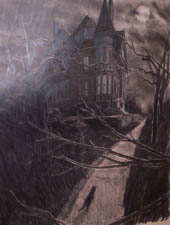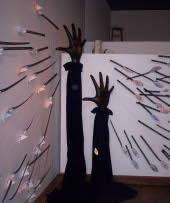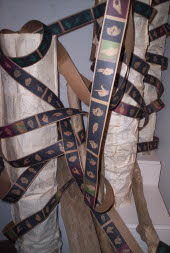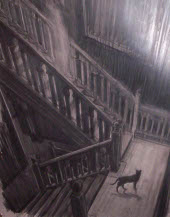 Creepy bunny costumes rendered in charcoal on paper, elongated hands rising out of the water to scratch at the stormy sky, a long, unspooled, film-like reel of hands signing out a missive wrapped around toppled driftwood pillars, and a possible gate to the underworld are parts of two separate book-based bodies of work now at Quad City Arts. One set re-presents the familiar with superb technical eloquence, utilizing the book as an end-product receptacle. The other, more adventurous body of work requires the book to become a component of the viewer's experience of the show.
Creepy bunny costumes rendered in charcoal on paper, elongated hands rising out of the water to scratch at the stormy sky, a long, unspooled, film-like reel of hands signing out a missive wrapped around toppled driftwood pillars, and a possible gate to the underworld are parts of two separate book-based bodies of work now at Quad City Arts. One set re-presents the familiar with superb technical eloquence, utilizing the book as an end-product receptacle. The other, more adventurous body of work requires the book to become a component of the viewer's experience of the show.
These recent works of Bruce Walters (an associate professor in the art department at Western Illinois University) and Kathryn M. Anderson (an assistant professor and colleague of mine in the art department at St. Ambrose University) are on display through February 15, with an opening reception from 7 to 9 p.m. on Friday, January 11.
For this exhibition, both artists incorporate some form of "book arts." Walters has a long horizontal stream of charcoal drawings, digital illustrations, photographic studies, and conceptual and organizational notations regarding how a book of Halloween images might be assembled. (The book is a future product with its formative stages currently on display.) Anderson has a series of 13 books that serve almost as "mood pieces" to inform and accentuate what is taking place in her various installations, and another more complete book that provides a tangible narrative for her works.
The difference between their uses of the book touches on an ongoing form-versus-concept debate amongst artists. Is the purpose of an artistic object to create beauty or provide an experience? Walters' work leans toward the formal importance of the object: A handsome book full of beautiful images is the desired outcome. Although Anderson's work is also concerned with making enticing images, it fundamentally is made with the desire to generate questions and analysis in the viewer.
Deciphering the Code
 Anderson's herstoryhistory is a series of works rooted in how mis-remembering or only partially remembering events can alter our lives. In her artist statement, Anderson poses the question: "Could these memories be rendered comprehensible in a different language (visual or verbal)?" In her work you see attempts at coalescing the fragments of memory through reorganizing, reconstructing, and translating information through sign language, Morse code, illustrations, and physical installations of objects. By giving an ephemeral memory a physical form, Anderson hopes to solidify what might otherwise become evanescent.
Anderson's herstoryhistory is a series of works rooted in how mis-remembering or only partially remembering events can alter our lives. In her artist statement, Anderson poses the question: "Could these memories be rendered comprehensible in a different language (visual or verbal)?" In her work you see attempts at coalescing the fragments of memory through reorganizing, reconstructing, and translating information through sign language, Morse code, illustrations, and physical installations of objects. By giving an ephemeral memory a physical form, Anderson hopes to solidify what might otherwise become evanescent.
Anderson's 13 small handmade books (Dada 1, Dada 2, etc.) have an intriguing dreamlike fragmentation in their flowing and sometimes cloudy imagery of vintage nude females, swirling forms, harrowing birds, snippets of disjointed text, and unexpected folds and stitched elements. The words create a mood rather than establishing a narrative. In one book, over the course of several pages, the text reads "has," "yet," and "No."
Anderson has also created an installation in a corner space with two elongated arms (each more than five feet long) wrapped in dark-purple velvet sleeves crowned by smooth and stylized black plastic hands. A series of "rays" bursts from the two open hands along the two walls. The "rays" are strands of dark thread tied to long black strips of paper, which in turn are anchored to the backs of more than 60 folded paper vessels. The strips of paper are perforated in Morse-code fashion with rectangles and circles and seem to form tails or streamers from the stern of the marbleized paper boats.
Marbleizing is traditionally a process in which the artist floats oil-based colors in swirling patterns on the surface of water in a tray and then lays a piece of paper flat on the liquid. Because oil and water don't mix, the paper will retain the flowing shapes of the oil colors as they were on the surface of the water. The artist can coax and guide the flow of the colors and can gain some control over the final product, but the lack of repeatability within the process means that each marbleized piece is a monoprint.
The folded paper vessels contain several ideas. The way a boat would bob around at the mercy of the water mimics how the oil-based colors float on the surface in the marbleizing process. The black tails with their coded information attached to the larger head-like boats elicit comparisons to sperm, possibly energetic tadpoles, or even messages in bottles. The individual variations of similar traits (swirls, clouds, and flowing lines) reinforce the interpretation of some kind of genetic code or information-carrier.
 In her installations, Anderson cultivates a sense of frustrated attempts to establish communication. The vessels that spring from the hands are never shown arriving at a destination. In a separate installation on the other side of the wall, there is a long spool of hands signing a message. Because the spool is hopelessly wrapped around driftwood, it is highly unlikely that its intended recipient will ever obtain the message. This failure to connect because information was not properly received is alluded to in Anderson's artist statement. It also plays out in her standalone book herstoryhistory.
In her installations, Anderson cultivates a sense of frustrated attempts to establish communication. The vessels that spring from the hands are never shown arriving at a destination. In a separate installation on the other side of the wall, there is a long spool of hands signing a message. Because the spool is hopelessly wrapped around driftwood, it is highly unlikely that its intended recipient will ever obtain the message. This failure to connect because information was not properly received is alluded to in Anderson's artist statement. It also plays out in her standalone book herstoryhistory.
In addition to being its own work, herstoryhistory serves as an informal guide to assist in deciphering Anderson's other pieces. It has an evocative and more coherent poetry and imagery than what is found in the fragmented poems of the 13 Dada books.
Unlike the variety of images within those, the same crisp black-and-white image is repeated four times within herstoryhistory. In it we see a boiling and tumultuous sea flowing throughout the composition with a series of elongated arms (highly reminiscent of the installation) jutting out in the top register like the weathered wooden pillars that used to support a pier. The clouds overhead seem to morph into animal shapes. Toward the bottom stands a mysterious woman with a persistent gull flying near her head.
As the narrative unfolds, the image is continually re-presented, but in each instance, Anderson has accentuated a different stage of the story by the addition of a small passage of aqueous blues, purples, and reddish browns.
The four images are separated by passages of poetry, such as "For many years he resisted the lull of the tide just to glimpse her horribly weepy fingers ... " and "How his cunning liquid void has ruined her for all naught! For it is there, where the discreetly tethered ship lists carelessly, threatening to suffocate her from the inside, that shall forever wait in time." These help to solidify the vague and only partially remembered dream images presented in the Dada books.
Anderson's books and the installations are not content to merely be seen; they also entice the viewer to explore and interpret what is going on. Their lack of specificity affords them a satisfying multiplicity of meaning.
A Glimpse Into the Process
 Bruce Walters gives viewers an excellent glimpse into the process of gathering images and ideas. His main body of work for this show is a book-in-progress that consists of a roughly 40-foot-long metal band running horizontally at chest height with more than 55 images held in place with magnets along its entire length.
Bruce Walters gives viewers an excellent glimpse into the process of gathering images and ideas. His main body of work for this show is a book-in-progress that consists of a roughly 40-foot-long metal band running horizontally at chest height with more than 55 images held in place with magnets along its entire length.
The images run the gamut from photographic studies of gnarled tree limbs, foreboding cloud formations, dilapidated stone walls, and broken sidewalks punctuated with tufts of weeds to colorful illustrations of kids in costume and "finished" charcoal drawings of dramatically illuminated wooden stairwells with ghostly forms and Victorian houses exuding palpable history and menace.
Walters includes notebook paper and some sticky notes for viewers to contribute their ideas about the images present (and possibly suggestions for others) and place their comments throughout the layout. The magnets suggest that the current order of images is not fixed.
He also shows some of the behind-the-scenes design concepts for constructing images. Several pieces include an organizational grid behind the figures, and one even diagrams how the invisible lines of force projecting off buildings lend structure to the negative space in the sky. His charcoal drawings demonstrate a keen eye for translating proportions, establishing movement and balance, and using the interplay between passages of light and dark to direct the viewer's attention and establish mood. These are excellent how-to examples and should be studied by art students in drawing or design.
One of Walters' more arresting charcoal drawings is of an old open wooden stairwell seemingly illuminated by a shaft of moonlight. The viewpoint heightens the severity of angle of the balusters, whose dense repetition leads your eye to the open landing where a black cat is darting up the stairs, only to be stopped motionless by the ghostly white form a few steps above it.
 Walters' color illustrations and charcoal drawings are masterfully rendered. He can summarize a pose or an expression with a few essential strokes or smudges. His visual structure actively guides the viewer through his compositions. His selection process from his research studies and sketches allows him a visual economy in his drawings that few artists can achieve.
Walters' color illustrations and charcoal drawings are masterfully rendered. He can summarize a pose or an expression with a few essential strokes or smudges. His visual structure actively guides the viewer through his compositions. His selection process from his research studies and sketches allows him a visual economy in his drawings that few artists can achieve.
What is harder to find, though, is depth or conceptual surprise within the standard Halloween/autumn fare presented here. There is one intriguing exception: Skeleton Door, which is a dull white door with a gesturally painted partial skull and body.
If death is a door we must all go through to enter the next phase of the journey, then this could be the guardian or the gate-keeper to another realm. This added level of meaning taps into the imagery and traditions of the Day of the Dead. Unlike most of his other images, it becomes more than just a stunning visual; Skeleton Door's materials and ambiguity evoke questions and interpretations.
For the most part, though, while Walters' works are effective in their way, they don't ask much of the viewer beyond enjoying their formal qualities. They re-present familiar (and relatively family-friendly) images of Halloween and are meant to be looked at, but not necessarily contemplated or analyzed. By comparison, Anderson's images, while sometimes oblique, are visually intriguing and require effort on the part of the viewer to decipher.








